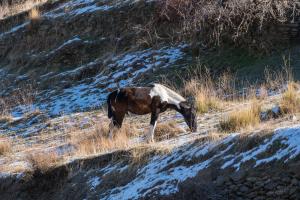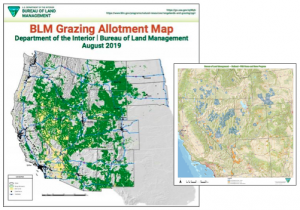It’s 2022 and Time to do Better for Wild Horses
LOS ANGELES, CALIFORNIA, UNITED STATES, January 13, 2022 /EINPresswire.com/ -- For supporters of the country’s wild horses and burros, 2021 will be remembered as a year of ever-increasing challenges and escalating problems.
The year ended with December 2021 marking the 50th anniversary of Federal protections for America’s wild horses. A 50th anniversary is a milestone to be celebrated. And rightly so! The occasion should mark half a century of commitment.
The Bureau of Land Management expressed the importance of the 50th anniversary when it announced “the agency was embarking on a year-long commemoration of The Act, highlighting the clear connection between Americans' support for the wild horse and burro adoption and sales program and the agency's mission to preserve and protect wild horses as part of a thriving ecological system on public lands.”
In the Bureau’s document titled the WFRHBA 50th Anniversary Commemoration Concept Paper it was stated “The year 2021 marks the 50th anniversary of the Wild Free-Roaming Horses and Burros Act (WFRHBA). Few pieces of legislation throughout American history have enjoyed such broad support among the American people. The Act was passed unanimously by both houses of Congress and signed into law by President Richard M. Nixon on December 18, 1971. Since that time, Americans across the spectrum have continued to passionately support the aims of the Act. (The) National Program Office (is) coordinating a year-long, nationwide commemoration of the Act in concert with BLM State and Field Offices.”
In his statement when signing the Bill To Protect Wild Horses and Burros, President Richard Nixon stated “I take special pleasure today, therefore, in signing strong new legislation to protect these noble animals.” With the 50th mile marker of the Wild and Free-Roaming Horses and Burros Act of 1971 having just passed, it’s reasonable to believe that the country’s wild horses and burros are safe and cared for on America’s public lands. Their supporters feel this isn’t the case.
Adversity replaced celebration for advocates of wild horses. A few of the situations seen by the wild horse protection community in 2021 were:
* Increasing numbers of wild horses adopted through the Adoption Incentive Program ended up in kill pens.
“Records show that some people who are paid $1,000 a head by the government to give legally protected Mustangs “good homes” are sending the horses to auction once they get the money.” https://www.nytimes.com/2021/05/15/us/wild-horses-adoptions-slaughter.html
* Senator Feinstein called on the Bureau of Land Management to suspend adoptions and investigate fate of adopted wild horses.
May 27 2021 Washington, D.C.—Senator Dianne Feinstein (D-Calif.) called on the Interior Department to suspend its Wild Horse and Burro Adoption Incentive Program over reports that some program participants have abandoned animals at slaughter auctions in direct opposition to the program’s requirements.
“I write with great concern regarding the attached New York Times article, which indicates that the Department of the Interior’s Bureau of Land Management (BLM) Wild Horse and Burro Adoption Incentive Program has provided federal incentive payments to adopters who abandoned these animals at slaughter auctions,”
I strongly urge BLM to immediately suspend this program and conduct a thorough investigation to ensure federal funds are used to protect wild horses and burros against abuse, neglect, or slaughter, as intended by Congress.” https://www.feinstein.senate.gov/public/index.cfm/press-releases?ID=02C96A16-6B68-4039-82BE-73F47AB8B4B0
* Supporters became aware of the publication of a newly proposed Wild Horse Council in the recent Senate Appropriations document. The wording for this taxpayer funded Council does not include any participation by non-governmental individuals or organizations working for the interests of the horses and burros, the climate or the environment.
“Therefore, the Committee directs the Secretary of the Interior, in conjunction with the Secretary of Agriculture, to establish and lead an interagency Wild Horse Council, with representation from BLM, Fish and Wildlife Service, U.S. Geological Survey, and Forest Service, and any other Federal agencies the Secretaries deem appropriate. This body will assess threats to equine health, public lands, and native species; initiate studies to address these issues; and make recommendations for maintaining healthy herds on a restored landscape. Further direction is provided under the ‘Management of Lands and Resources’ heading in this explanatory statement. (Page 7) https://www.appropriations.senate.gov/imo/media/doc/INTRept_FINAL.PDF
Supporters now see 2022 beginning with the Bureau of Land Management again announcing increased captures and removals of horses and burros in their January 5th Press Release. https://www.blm.gov/press-release/blm-releases-annual-plan-wild-horse-and-burro-gathers-and-fertility-control
In spite of ongoing statements that wild horse removals will be increased due to damage they cause to the land, P.E.E.R, Public Employees for Environmental Responsibility, documented livestock as the major cause of land degradation using the Freedom of Information Act.
In the report prepared by P.E.E.R., addressing rangeland health, the following findings were presented.
“These figures are derived from BLM land health standards assessment datasets obtained through the Freedom of Information Act. The land health status records the most current assessment conducted through 2020.
• BLM’s records reveal that most of the allotments within HMAs that fail land health standards identify livestock as a significant cause of degradation of land health--approximately 11.5 million acres of the 21.5 million acres of allotments within HMAs assessed by BLM to date. Livestock is by far the most frequently identified cause of allotment failure to meet fundamental land health standards nationwide, and for allotments within HMAs (Herd Management Areas).
• BLM’s records also reveal that most of the area within HMAs that are within allotments failing to meet land health that identify livestock as a significant cause of degradation, also identify wild horses as a cause of land health degradation.
• Of the almost 22 million acres of HMA area within allotments that BLM has assessed, only a tiny fraction, 1%, 311,000 acres has been identified as failing due to wild horses alone, with no mention of livestock.”
In addition to land degradation, the wild horse captures and removals are attributed to environmental damage. In an article published by the Sierra Nevada Ally on December 6, 2021, cowritten by Charlotte Roe, Founder Wild Equid League of Colorado, and Erik Molvar, Executive Director of Western Watersheds Project, Mr. Molvar states “While wild horses and burros – and other wild herbivores like elk and deer for that matter – potentially affect the climate, the overwhelming majority of climate impacts come from domestic livestock. Nonetheless, a research focus on the climate implications of cattle and sheep or their impacts on western public lands is nowhere to be found.
This isn’t only a theoretical omission, it’s an active dereliction of the agency’s duties to address reality. Recent “emergency” roundups of wild horses have been followed immediately by massive influxes of livestock, illustrating that the Bureau of Land Management removes wild horses only to make way for commercial herbivores. Case in point: In the Sand Wash Basin of Colorado, the Bureau rounded up 501 horses — over 60 percent of this storied herd — under the pretext of emergency drought conditions, despite calls for a halt by Governor Jared Polis, Representative Joe Neguse, and numerous wild horse advocacy and environmental organizations. Weeks after the roundup ended, more than 5,000 sheep were released to graze the same “drought-parched” land.
In Wyoming, the BLM is now removing over 3,500 wild horses from 4 million acres in the Red Desert Complex, including the wild horses of the Salt Wells watershed with curly pelage, a rare genetic variation. These lands are already meeting the “thriving natural ecological balance” legal standard according to BLM, even with the present 5,600 wild horses present before the roundup. Total roundup cost: $175 million. Chief beneficiary: the Rock Springs Grazing Association, which turns out mass quantities of cattle on public lands at the cut-rate cost of $1.35 per cow-calf pair per month, a fraction of the $23.40 a month average charged for private land grazing.
What’s wrong with this picture? Just about everything. The Bureau’s scapegoating of wild equids for ecological damage – and climate impacts – caused by cattle and sheep allows the agency to continue to ignore the real cause of land degradation and its genuinely serious climate consequences. This failure to engage the real issue extends and deepens the climate crisis.” https://www.sierranevadaally.org/2021/12/06/lets-be-honest-about-cattle-wild-horses-and-climate-solutions/
Members of the public supporting wild horse protection ask that these issues be addressed. They continue calling on the President and Congress to use taxpayer funding to maintain the range and keep the horses in their designated HMAs rather than spending the money on roundups and holding facilities. Supporters believe, if animal removals are necessary, the BLM should first remove livestock from HMAs, then provide the food and water resources necessary to maintain the horses that are the Federally designated primary beneficiaries of these lands.
Donna Brorein, Advocacy News
American Equine Awareness
+1 770-870-7589
email us here



